The Forest Quartet review – Short narrative puzzler for people who enjoy emotionally touching musical experiences

- 0 Comments
As a new parent (and overall busy fellow), I now find bite-sized adventures to be a blessing. With only so many full-length games I can fit into a given month, I’ve recently thrived on puzzle games that tell fresh, moving narratives within a single play session.
Enter The Forest Quartet, a filler-free artistic triumph from first-time developers Mads & Friends, who have delivered a deeply personal story that’s almost guaranteed to resonate with musicians or any sort of creative artist. It may be a bit light on actual puzzles, but the two-hour journey is well worth the time – especially for anyone who’s ever picked up an instrument (and liked it). It’s beautiful to look at, sonically rich, brought a tear to the eye, and was over before I knew it – but left an impression I’m sure to be thinking about for a good long while to come.
The Forest Quartet opens on a somber note: Nina, the lead singer of the titular jazz band, has passed away. To grieve, the remaining members of the eponymous foursome are planning a farewell concert deep in the woods to say a proper goodbye to their fans (and to Nina) in three days’ time. However, each band member has their own hangups about following through on this promise, and that’s where the player comes in.
You play as the ghost of Nina, ascending from her woodland grave to float through lush environments in an overhead perspective. You’ll help her circumnavigate barriers and solve the occasional puzzle on her journey to reach the homes of her forest-dwelling bandmates. The three musicians – a pianist, bassist, and drummer – are each well-rounded characters whom we come to know through snatches of podcast-style flashbacks from an interview with the full band in a happier time before Nina’s passing. These bits of audial storytelling form the bulk of the narrative and play out over the course of the adventure while you explore the woods. The quality of the writing here deserves special praise, as does the voice acting – it’s all so rich yet natural that, for a while, I wasn’t sure if these were scripted lines or lifted from a real-life interview.
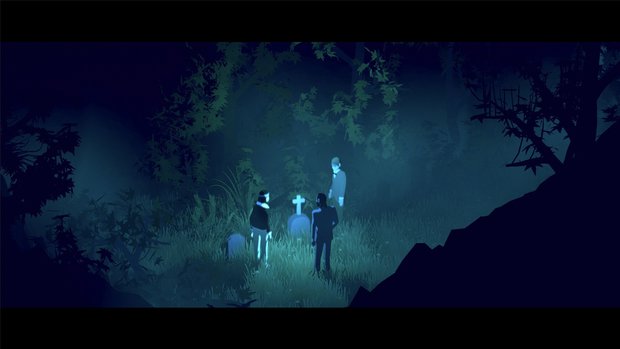
Each band member finds themselves in their own unique conundrum and needs a little push of inspiration that only Nina can provide. The goal is to help the three musicians break through the mental blocks preventing them from assembling for their goodbye performance at the pavilion, and fulfill their promise to the awaiting crowd. One lacks the drive, another’s wracked by fear, and one is so overcome by anger that they can’t even take action.
The environments change to mirror the internal struggles of each musician. The pianist, having lost his spark of inspiration, resides in an area overgrown by colorful fungi that is causing significant decay to the woods, while the bassist, suffering anxiety, lives in a much darker part of the forest, where the puzzles revolve around bringing light to ward away imaginary shambling silhouette creatures (that manage to be creepy and cute in equal doses).
Just like a good bedtime story, The Forest Quartet is the sort of game that immediately put me in the mood for a good night’s sleep. A story about loss and mental illness might not seem like the sort of thing one might want to wind down to, but this game exudes a genuine warmth that made it feel like everything was going to be alright – an experience akin to a loving hug.
This happened without fail, every time I booted it up. Despite the short length, I still had to spread the experience over four nights because even a few minutes of play was enough to soothe me in a very restful state, and I didn’t want to miss a moment. Ultimately, I think of this as a major plus, and quite fitting too, considering the publisher behind goes by the name Bedtime Digital Games.
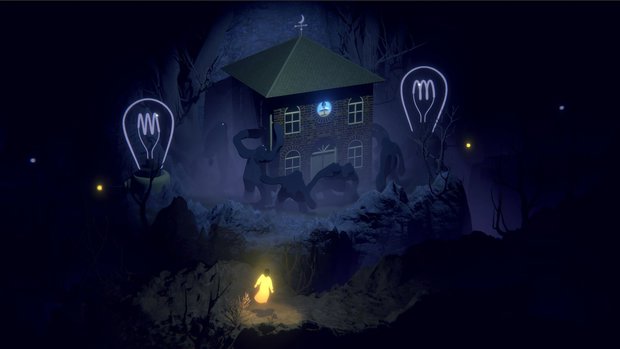
Right from the get-go, I was taken by the graphical style, which renders everything with a very stylized, almost illustrative look, but in full 3D. Literally any moment of gameplay would make for a beautiful screenshot. Adding to the visual splendor is the fact that Nina’s ghost acts as a dynamic light source, adding a warm glow to her surroundings that casts all sorts of lovely shadows.
The environment also reacts in very satisfying ways to player interaction. Pressing your “Interact” button (mainly used for lighting lamps with a pleasing snap) will make the surrounding environment vibrate in a visually dynamic fashion, almost as if the world were made of Lego blocks that threaten to come undone. This has no effect on the gameplay at all – it’s just a very satisfying flourish that further indicates how much passion was put in by the devs. Fun little touches like this abound from start to finish.
The game’s music and audio design serve as the perfect pairing to the graphics, enriching the forest with outstanding atmosphere. The jazz music of The Forest Quartet is endlessly re-listenable, and the sound effects (primarily thumps, rattles, plucked keys and other elements of a jazz band kit) all feel spot-on. I just wanted to soak in every single sound and bit of music the game had to offer, and did my best to do so. Most players will reach the end in just a couple of hours, but I logged nearly three and a half – and it wasn’t because I got stuck.
The chill, laid-back vibes extend to the game design, too. For the first half hour of play, I had a nearly puzzle-free experience, almost like a narrative exploration game such as Gone Home or Firewatch that just happened to be played from an overhead perspective rather than the more typical first person. But soon enough, genuine puzzles began to emerge and brought a (small) bit of brainteasing challenge, though once all the various mechanics had been introduced, it wasn’t long before the puzzles fell by the wayside again, disappearing almost as soon as they’d appeared in favor of focusing on the story.
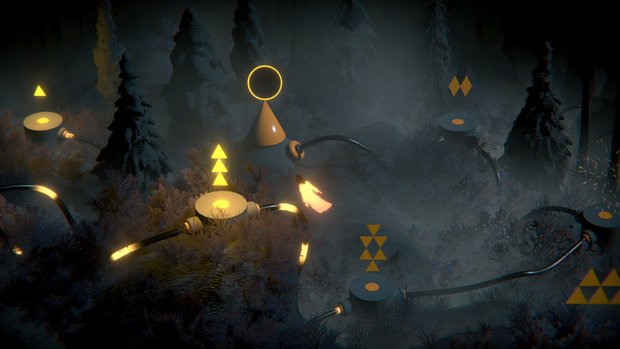
Many of the puzzles involve using Nina’s abilities to traverse barriers, whether that means singing to activate (or clear away) environmental objects, or using flight to get across small gaps. Eventually other puzzles emerge that involve picking things up and setting them down in the right spot (sometimes in obvious ways, sometimes less so) or “drawing” the appropriate pattern while connecting dots with strands of light, almost like rudimentary electrical wiring.
There was one unclear moment where I just didn’t understand why the game wouldn’t accept the way I’d connected some of those dots, and I couldn’t find any sort of environmental clue to tell me how it should’ve been. That said, when I looked up a guide for a gentle nudge, I suppose I’d have gotten it with another guess. Overall, though there aren’t any masterful riddles at play, the puzzles are a fun little diversion from the narrative that rarely frustrate.
The final section of the game, while boasting some impressive visuals, carries almost no challenge, mostly requiring you to interact with all the various objects onscreen in the ways you’ve already been trained to, with little in the way of lateral thinking. Still, the story is engaging up to the end, and as events progress toward a moving finish, the narrative gets more and more interesting. The flashback interviews with the musicians reveal touching layers of humanity, shining a light on their wants and dreams, their very human need to form a sense of community, and their mental health struggles that have been partly remedied and yet also worsened since moving away from the city in favor of the forest. There’s some very choice quotes sprinkled throughout the interviews that I’ll remember for a while, like “Drummers don’t have anger issues. They have anger. If they don’t have a drum, then there’s an issue.”
The lack of challenge can be read as a plus or minus depending on the player, but one of the few needless drawbacks (that’s sure to please no one) is the fact that you can’t really pause the game at all. This isn’t much of a problem during normal gameplay, where nothing is really timed and there’s no sense of danger – but it becomes quite a hassle when, for instance, you perhaps get a phone call right as a cutscene starts to play. If you hit the Escape key, it just brings up a menu overlay while the game continues to run behind it – yes, even in cutscenes! That’s just baffling.
Even if the game didn’t have puzzles at all, I don’t think I’d have been bothered too much by it. The Forest Quartet is like something you might play at a museum – an experiential work of art, bolstered by its touching yet minimalist narrative and abundantly gorgeous sights and sounds. And it feels like it’s made for everyone, young and old, whether they’re veteran gamers or fairly new ones. Every puzzle is like a fun toybox, each interaction a tempting joy to trigger. I spent a decent amount of time deliberately having Nina float aimlessly about, circling trees and singing while mashing the Interact key to see how various parts of the environment vibrated. I guess I’m a man of simple pleasures, and this game entertained my inner child, big time.
Final Verdict
Overall, I loved my time with The Forest Quartet, even though its pleasantly bite-sized nature also limits some of the weight of its narrative payoffs. Still, it’s the sort of game that feels just the right length for its premise, and aside from its wonky lack of pausing, I wouldn’t change a thing.
Hot take
Full of gorgeous art, delightful jazz, and a very light amount of challenge, The Forest Quartet turns a story about death and grief into a fun, lively, cathartic memorial romp.
Pros
- Beautiful art style
- Terrific, believable character writing
- Sonically rich atmosphere that begs to be explored
Cons
- No way to pause during cutscenes
- Many sections are quite light on gameplay
Sean played The Forest Quartet on PC using a review code provided by the game's publisher.

- Advertisement
- Help support AGH by advertising with us


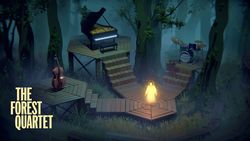







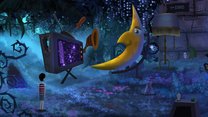
0 Comments
Want to join the discussion? Leave a comment as guest, sign in or register.
Leave a comment